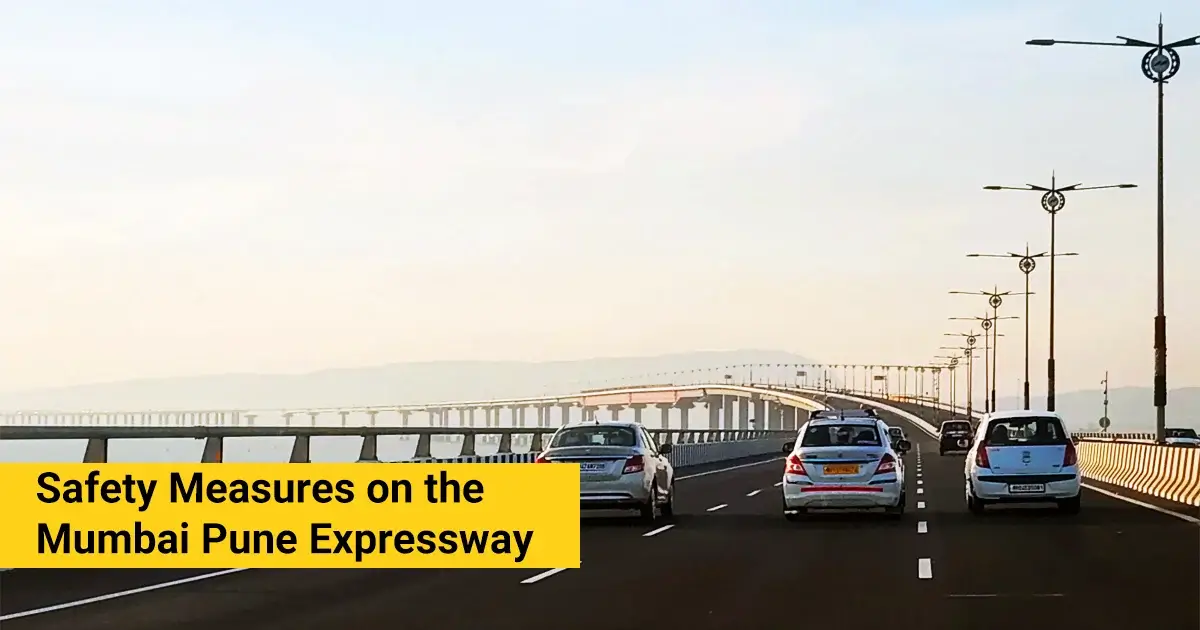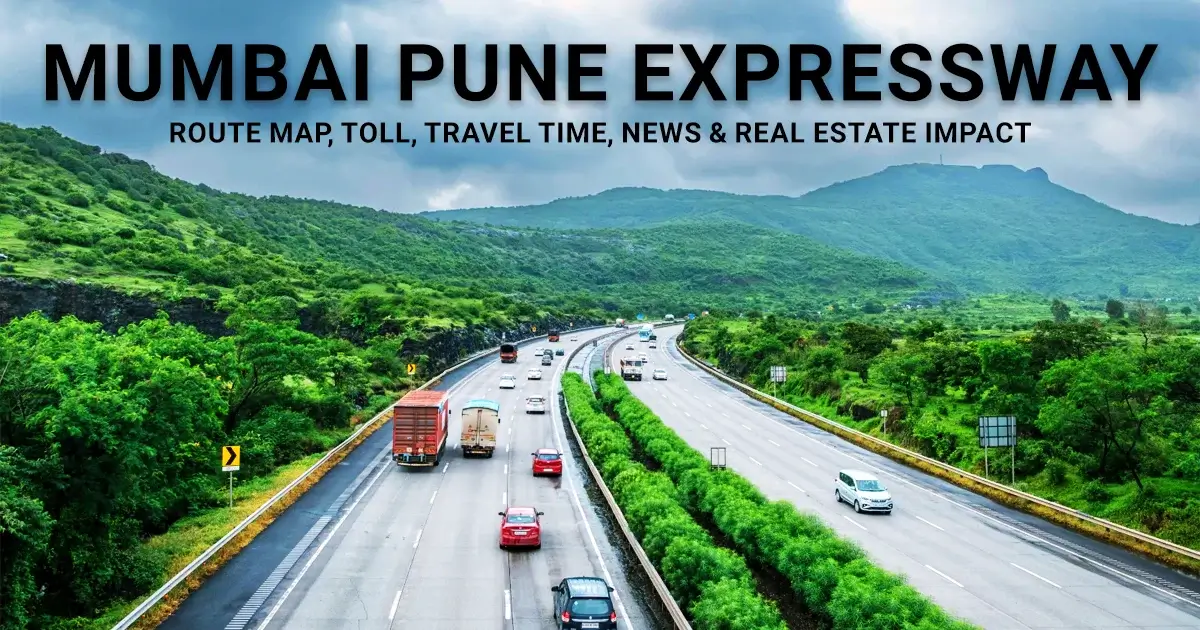The Mumbai-Pune Expressway, also referred to as the Yashwantrao Chavan Expressway, is a landmark in Indian infrastructure. Since its inception in April 2002, it has completely changed intercity travel between Mumbai and Pune, two of the busiest and economically important cities in Maharashtra. The 6-lane expressway intends to diminish travel time, provide road safety, and offer organized flow. It is India’s first access-controlled toll expressway.
The Mumbai Pune Expressway news updates, speed limits, route map, toll charges, as well as safety rules, real estate impact, and expansion planning, are all included in this detailed Mumbai Pune Expressway guide 2025.
What is the Mumbai Pune Expressway?
| Particulars | Details |
| Expressway Name | Yashwantrao Chavan Expressway |
| Total Distance | 94.5 km |
| Start Point | Kalamboli, Navi Mumbai |
| End Point | Kiwale, Pune |
| Number of Lanes | 6 lanes (3 on each side) |
| Type | Concrete, access-controlled |
| Inauguration Year | 2002 |
| Developed By | Maharashtra State Road Development Corporation (MSRDC) |
| Project Cost | ₹16.3 billion |
The expressway was built by MSRDC and is functioning under the Build-Operate-Transfer (BOT) model, where the rights to collect tolls would last till 2045.
Read also: Expressways of India 2025: The Ultimate Road Trip Upgrade
Mumbai Pune Expressway Route Map & Key Interchanges
The expressway starts at Kalamboli in Navi Mumbai and ends at Kiwale near Pune. It crosses through the Sahyadi mountain range, having six major tunnels and many viaducts in between. The route allows for an uninterrupted journey and avoids some of the most congested urban stretches.
Some Key Interchanges Along the Route Include:
- Kon (Shedung)
- Chowk
- Khalapur
- Kusgaon
- Talegaon
Important Structures Along the Route Include:
- Bhatan Tunnel
- Madap Tunnel
- Adoshi Tunnel
- Khandala Tunnel
- Kamshet Tunnels (1 & 2)
These tunnels together measure a length of 5.7 km and provide beautiful views as well as assist in maintaining a steady pace of travel.
History and Timeline of the Mumbai Pune Expressway
The expressway traces its history back to 1990, when RITES was appointed to carry out a feasibility study. Environmental clearances and forest clearances were obtained in 1997. MSRDC awarded the contracts to four developers, and construction work started in 1998. The last leg started operating in April 2002.
| Year | Milestone |
| 1990 | Feasibility study initiated by RITES |
| 1997 | Construction sanctioned; tenders invited |
| 1998 | Work officially begins |
| 2002 | Expressway opens for public use |
Mumbai Pune Expressway Toll Charges (2025)
Toll passes need to be paid by travelers in two main plazas:
- Khalapur Toll Plaza (Mumbai-Pune)
- Talegaon Toll Plaza (Pune-Mumbai).
| Vehicle Type | Toll (Approx.) |
| Cars / SUVs | ₹250 |
| Light Commercial Vehicles | ₹400 |
| Buses / Trucks | ₹675 |
| Multi-Axle Vehicles | ₹1,750 |
The toll rates will be due for periodic revisions. Due to increase in maintenance and extension of facilities, consideration is being given to the proposal to extend tolling beyond 2045.
Read also: Dwarka Expressway Delhi: The New Growth Corridor of Delhi-NCR Real Estate
Mumbai Pune Expressway Travel Time & Peak Hours
A gigantic cut in travel freedoms between Mumbai and Pune now brings them to around two or two and a half hours as opposed to four to five hours along the old highway.
Peak Hours to Avoid:
- Friday Evenings (Mumbai to Pune)
- Sunday Evenings (Pune to Mumbai)
- Holidays and extended weekends
During those times, vehicle volume shoots up from 75,000 to more than 1,20,000 vehicles in one day, which results in jams-majorly at Lonavala and Khandala.
Updated Speed Limit on Mumbai Pune Expressway
In order to enhance safety and mitigate accidents, updated speed limits are enforced based on terrain and vehicle type classification:
| Vehicle Type | Flat Terrain | Ghat Section |
| Cars (M1 Category) | 100 km/h | 60 km/h |
| Buses/Minibuses (M2/M3) | 80 km/h | 40 km/h |
| Heavy Goods Vehicles | 80 km/h | 40 km/h |
Monitoring speed using Intelligent Traffic Management Systems (ITMS) installed at critical points, issuing e-challans in case of violations.
Latest News: The Missing Link Project (2025 Update)
The seismic Mumbai Pune Expressway Missing Link Project is in development by the construction company and is expected to be operational by December 2025.
Read also: What is a Possession Certificate? Format, Application, and Difference
What is this all about?
This is a bypass stretch of a length of 13 kilometres between Khopoli and Sinhgad Institute (Pune), the stretch of the link being relatively free from severe jammed movements experienced in the area of the Lonavala-Khandala ghat section.
Highlights:
- Eight lane dual tunnels: One of 8.92 km in length and another 1.75 km long.
- Different cable-stayed bridges of 640 m and 770 m.
- The deepest tunnel segment lies 170 feet below the grounds of the Lonavala lake.
Project Cost:
- An estimated ₹6,695 crore.
Reduction of Travel Time:
- Estimated to cut down about 25 to 30 minutes for a journey.
The present project is expected to add considerable safety benefits while minimizing landslide losses and offering even better advantages in decongesting weekend traffic.
Safety Measures on the Mumbai Pune Expressway

These expressways were made quite secure, although naturally, they are especially vulnerable as they pass through the ghat sections.
Safety Features Included:
The Zero Fatality Corridor initiative to redesign black spots has also been part of the safety features incorporated on the expressway.
- Construction of barrier system and reflective signboards.
- Ambulances and cranes are stationed every few kilometers.
- Two-wheelers, tractors, and carts have also been banned.
Speeding, sharp gradients, and braking failures in hilly stretches saw most accidents occur on the expressway, yet the pressing reality is that this number is rather low.
Real Estate Effects of the Mumbai Pune Expressway
The Mumbai-Pune Expressway did more than just save time to travel between the cities; it also opened up large tracts of real estate that would otherwise be overlooked in the intervening areas.
Read also: Can NRIs Buy Agricultural Land in India?
Strategic Locations Fueling Growth
| Key Micro-Markets | Growth Drivers |
| Panvel | Proximity to Navi Mumbai Airport, CIDCO projects, and the JNPT Port |
| Khalapur | Affordable second homes and weekend villas, scenic views |
| Lonavala | Premium villas and tourism-centric resorts; popular for second homes |
| Talegaon | Industrial and logistics development; rising residential demand |
| Wakad & Hinjewadi | IT hubs near Pune; rapid growth in high-rise apartments and gated communities |
Infrastructure Catalysts
The expressway has attracted several parallel infrastructure projects, thus intensifying its effects:
- Navi Mumbai International Airport (NMIA) – an upcoming increased demand in Panvel and Khalapur
- Pune ring road & Metro projects – improving last-mile connectivity
- MIDC Industrial Zones – in Talegaon, Chakan, and Ranjangaon generating employment
Combining all of the above, several big developers came up with colossal projects along this corridor.
Residential Projects Along the Corridor
There have been a few leading real estate developers engaged in township-style and weekend homes ventures:
- Lodha Belmondo, Gahunje – A high-end riverside golf community project
- Shroff Shagun, Talegaon – Affordable flats with popular demand for rentals
- Garnet Crystal Spring, near Khalapur – Mid-segment homes in a perfect environment
- Xrbia Express City, Khalapur – Economical housing integrated with smart city planning
All these projects will entice end-users and investors alike, especially those on the lookout for:
- A better lifestyle away from congested city centres
- Quick weekend getaways
- Rental income from professionals commuting between cities
Commercial and Warehousing Boom
Talegoan and Khalapur are experiencing a logistics and warehousing revolution because of proximity to JNPT Port, quicker movement of freight through the expressway, and higher demand from the e-commerce and FMCG sectors.
In this way, more job opportunities will be multiplied, thereby further balancing the demand for housing in nearby areas.
Property Appreciation Trends
From 2015 to 2025, land rates and apartment prices in localities adjacent to the expressway, say Khalapur, Panvel, and Talegaon, will see appreciation with rates between 20% and 40%. Formerly, ‘remote’ places are now viewed as popular zones for smart investment.
MSRDC’s Development Plan:
- Leasing of 24 sites measuring 450 hectares for 99 years
- They focus greatly on developing wayside amenities, logistics hubs, and residential townships
Read also: Stay Order on Property: Vacate It with Legal Steps
Future Plans: 10-Lane Super Expressway by MSRDC
To increase traffic management, the MSRDC is in the process of transforming the Mumbai Pune Expressway into a 10 lane expressway as opposed to the existing 6 lanes.
Details of the Project:
- Estimated Cost: ₹14,260 crore
- Funding Source: Through toll collection funds and not through government funds.
- Current Status: Awaiting the approval of the State Government.
Proposed Start Date: 2026.
Once approved, this project would scale the expressway into one of the best in India.
It is, indeed, a great artery of corridors transforming India’s transport ecosystem that can be construed from Mumbai to Pune. Through intelligent planning and high-grade engineering and construction, the relentless expansion to development has resulted in such bridges being very likely names for new travel periods. Meanwhile, the authorities are pushing for the ambitious upgrades to this road, such as the Missing Link or 10-lane expansions, which is indeed set to define the next journey in mobility for Maharashtra.
Keep an eye open for official Mumbai Pune Expressway news channels and MSRDC announcements for the live updates about closures, toll revision, and traffic conditions.





Comments are closed